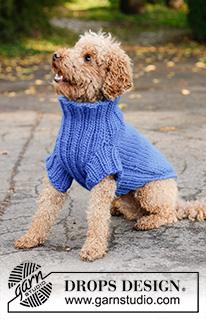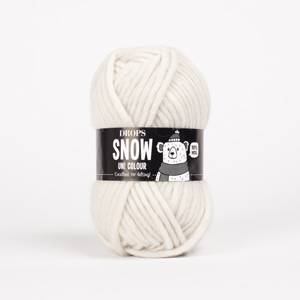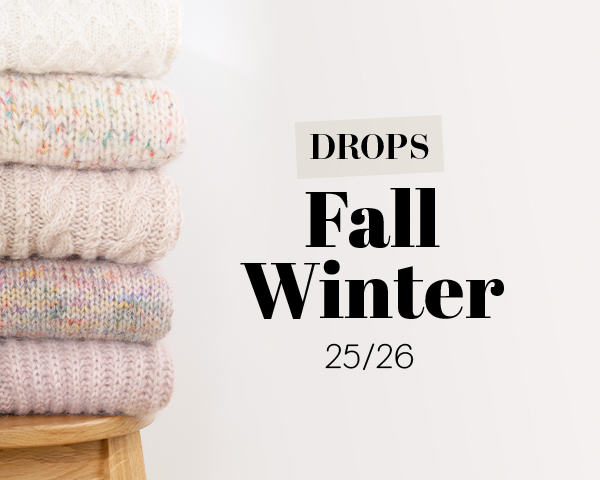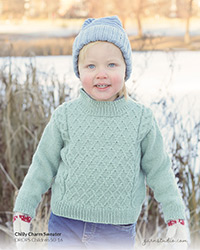Comments / Questions (41)
![]() Chantal wrote:
Chantal wrote:
Ik raak verward in de uitleg van de hals . Paar keer aan het lezen maar kom er niet uit. Is er iemand die me kan helpen met wat meer uitleg.
18.12.2025 - 21:41DROPS Design answered:
Dag Chantal,
Je zet de steken voor de rug en de buik allemaal bij elkaar op naalden zonder knop, waarbij je de steken van de buik op één van die naalden bij elkaar zet. Je kunt de steken ook op een rondbreinaald zetten en markeerders plaatsen aan beide kanten van de buiksteken. Je breit eerst over de steken van de buik, dan over de andere steken en je mindert een aantal steken over die andere steken zoals aangegeven. Dan brei je wat tussen sterretjes staat, dus heen en weer breien over de buiksteken en dan 1 naald over alle steken. Wat tussen sterretjes staat herhaal je 2-2-3-4. Vervolgens brei je over alle steken tot de aangegeven lengte.
27.12.2025 - 12:48
![]() Chantal wrote:
Chantal wrote:
J’aimerais simplement clarifier le rabat de 5 mailles 1 fois es-ce des deux côtés qui ferait 10 mailles rabattues ? Quand l’ouvrage mesure 27-31-35-41 cm, tricoter toutes les mailles en jersey, en même temps, rabattre tous les 2 rangs pour l’ouverture des pattes avant ainsi: 1 fois 5 mailles et 2-2-3-3 fois 1 maille. Tricoter 2 rangs, en même temps, monter 2 mailles de chaque côté (c’est la fin de l’ouverture pour les pattes avant) = 25-29-29-33 mailles.
04.11.2025 - 03:04DROPS Design answered:
Bonjour Chantal, on va rabattre 5 mailles au début des 2 rangs suivants (= 5 m de chaque côté), puis 1 maille au début des 4-'4-6-6rangs suivants (soit 2-2-3-3 m de chaque côté), puis vous montez 2 m à la fin des 2 rangs suivants (= 2 m de chaque côté). Bon tricot!
04.11.2025 - 08:20
![]() Gail Hoge wrote:
Gail Hoge wrote:
I’m a little confused and can’t seem to find the corrections to the Blue Shadow dog sweater. When piece reaches 4.75 inches and I cast on a stitch on both sides, do I continue to cast on stitches every row or just the one time-leaving 35 stitches on the needles?
24.01.2025 - 16:30DROPS Design answered:
Dear Gail, the online version is already the correct version; the correction notification at the bottom is a warning for those who printed the pattern before the correction date. You cast on 1 edge stitch on each side only once (so you have 35 stitches); this is the edge stitch which later will be used for sewing the piece together. Happy knitting!
25.01.2025 - 19:31
![]() Busana wrote:
Busana wrote:
Bonjour, Je ne comprends pas l'explication du col. Pourquoi repartir les mailles du dos sur 3 aiguilles, alors que ces 3 aiguilles ne sont mentionnées nulle part au début du modèle. Merci
24.01.2025 - 16:27DROPS Design answered:
Bonjour Busana, on tricote le col en rond sur les aiguilles doubles pointes, soit sur un jeu de 5 aiguilles, et on répartit les mailles sur 4 aiguilles ainsi: les 12-20 premières mailles sur la 1ère aiguille et on répartit les 25-29 ou 33 m sur les 3 autres aiguilles, on a ainsi les mailles sur 4 aiguilles et on tricote en rond avec la 5ème aiguille. Bon tricot!
27.01.2025 - 08:07
![]() Kim McLeveighn wrote:
Kim McLeveighn wrote:
My dog’s measurements make him a small, but I don’t understand how 8?stitches in the tummy are supposed to fit. His chest is 18”, length from the base of his neck to base of tail is 15”. Thanks for your help.
26.12.2024 - 04:06DROPS Design answered:
Dear Kim, since your dog seems to be right at the upper edge of the S size, you may need to work the next size for certain instructions. You could try casting on 16 sts or an intermediate number that matches your dog's tummy: just make sure that these stitches can fit the indicated rib pattern. Happy knitting!
29.12.2024 - 21:20
![]() Diane Goyette wrote:
Diane Goyette wrote:
J ai besoin d explications pour Drops Extra 0-81 patron ee-765, je ne comprends pas bien vos explications com j attends de l aide merci
06.12.2024 - 21:27DROPS Design answered:
Bonjour Mme Goyette, n'hésitez pas à nous indiquer à quel niveau vous avez des problèmes, quelle partie vous ne comprenez pas, ainsi, nous pourrons vous aider. Merci pour votre compréhension.
09.12.2024 - 07:49
![]() Kim McLeveighn wrote:
Kim McLeveighn wrote:
I’m finishing the back and I need help with the leg decreases. Where do I bind off 5 stitches 1x and 1 stitch 2x? That will leave 32 stitches, but after casting on 2 more stitches will be 24 stitches, not 29. Thanks for your help t
18.11.2024 - 21:05DROPS Design answered:
Dear Mrs McLeveighn, cast off at the beginning of each row on each side so that both legs opening are the same, this means you will cast off 5 sts at the beg of next 2 rows = 5 sts at the beg of row from RS and then 5 sts at the beg of next row from WS, then cast off 1 stitch at the beginning of next 4-6 rows (2-3 times on each side). In both middle sizes you should have 25 sts when all stitches are cast off, then cast on 2 sts on each side = 29 sts. Happy knitting!
19.11.2024 - 08:02
![]() Frédérique wrote:
Frédérique wrote:
Bonjour, Je suis un peu perdue au moment du col. Comment répartir les 25 mailles sur les 3 aiguilles ? Et ensuite, quand on commence la rehausse on commence par les mailles du ventre ou du dos? Merci beaucoup
29.10.2024 - 07:16DROPS Design answered:
Bonjour Frédérique, vous pouvez placer ces 25 mailles sur 3 aiguilles comme bon vous semble (par ex. 8 m sur les 2 premières et 9 m sur la dernière ou bien 9 m sur la 1ère et 8 m sur les 2 autres ou bien encore 8 m sur la 1ère et la 3ème et 9 m sur la 2ème). Les rangs raccourcis de la réhausse commencent par les 12 mailes de la 1ère aiguille = ceux du ventre. Bon tricot!
29.10.2024 - 09:51
![]() Betty Dooper wrote:
Betty Dooper wrote:
Ik zoek Colour 84 pauwblauw.Drops snow mix
17.04.2024 - 16:06DROPS Design answered:
Dag Betty,
Het bestellen van garens gaat via een van de verkooppunten die onze artikelen verkopen; wij verkopen geen garens via de site. Via deze link vind je een lijst met verkooppunten.
17.04.2024 - 21:47
![]() Susanne Bøttern wrote:
Susanne Bøttern wrote:
Jeg strikker størrelse L
09.01.2024 - 16:40
Blue Shadow |
|
 |
 |
Knitted dog sweater in DROPS Snow. The piece is worked from the tail to the neck with stockinette stitch and rib. Sizes XS - L.
DROPS Extra 0-81 |
|
|
------------------------------------------------------- EXPLANATIONS FOR THE PATTERN: ------------------------------------------------------- INCREASE TIP: Increase by making 1 yarn over, which is worked twisted on the next row to avoid a hole. The new stitches are worked in stockinette stitch on the back and rib on the tummy. GARTER STITCH (worked back and forth): Knit all rows. ------------------------------------------------------- START THE PIECE HERE: ------------------------------------------------------- DOG SWEATER - SHORT OVERVIEW OF THE PIECE: The piece is worked from the tail to the neck. The back and tummy are worked separately back and forth, then joined and the neck worked in the round. The back and tummy are sewn together to finish. BACK: Cast on 14-18-18-22 stitches with needles size 7 MM = US 10,75 and DROPS Snow. Work rib as follows (first row = wrong side): work (purl 2, knit 2) until there are 2 stitches left, purl 2. Knit over knit and purl over purl for a total of 3 rows. Work as follows from the right side: Knit 2, purl 2, work 6-10-10-14 stockinette stitches and increase 5 stitches evenly over these stitches - read INCREASE TIP, finish with purl 2, knit 2 = 19-23-23-27 stitches. Continue with stockinette stitch over the middle stitches and 4 ribbed stitches on each side. At the same time, increase 1 stitch after/before the ribbed stitches on each side every 2nd row a total of 7-7-8-8 times = 33-37-39-43 stitches. When the piece measures 12-12-14-14 cm = 4¾"-4¾"-5½"-5½", cast on 1 stitch on each side, these stitches are worked in GARTER STITCH – read description above = 35-39-41-45 stitches. The edge stitches are used when sewing the back and tummy together. When the piece measures 27-31-35-41 cm = 10⅝"-12¼"-13¾"-16⅛", work stockinette stitch over all stitches, binding off stitches every 2nd row for the front legs as follows: 5 stitches 1 time, 1 stitch 2-2-3-3 times. Work 2 rows and cast on 2 stitches on each side (the end of the openings for the front legs) = 25-29-29-33 stitches. The piece measures approx. 33-37-42-48 cm = 13"-14½"-16½"-19". Place the stitches on a stitch holder. TUMMY: Cast on 8-8-16-16 stitches with double pointed needles size 6 MM = US 10 and DROPS Snow. Work as follows from the wrong side: 1 edge stitch in garter stitch, (purl 2, knit 2) until there are 3 stitches left, purl 2 and 1 edge stitch in garter stitch. Continue this rib back and forth for 15-17-20-26 cm = 6"-6¾"-8"-10¼". Insert 1 marker in each side, which show where the openings for the front legs start and are used when assembling. Continue the rib until the piece measures 20-24-28-35 cm = 8"-9½"-11"-13¾". Now increase 1 stitch after/before the edge stitch on each side every 2nd row, 2 times = 12-12-20-20 stitches – remember INCREASE TIP – the new stitches are worked in rib. The tummy measures approx. 23-27-31-38 cm = 9"-10⅝"-12¼"-15". NECK: Place the stitches from the tummy and the back on double pointed needles size 6 MM = US 10, dividing them as follows: Tummy’s 12-12-20-20 stitches on the first needle, the 25-29-29-33 back-stitches divided between the 3 other needles = 37-41-49-53 stitches. Start on the tummy: Work 1 stockinette stitch, rib as before over the next 10-10-18-18 stitches, 1 stockinette stitch (first needle), work stockinette stitch and decrease 1-1-5-5 stitches over the back-stitches = 36-40-44-48 stitches. Work a small elevation as follows: * Work the 12-12-20-20 stitches on the first needle as before, turn. Work back as before, turn. Work 1 round of rib (purl 2, knit 2) over all stitches *, work from *-* a total of 2-2-3-4 times. Insert 1 marker to measure from. Work rib in the round over all stitches for 5-7-8-10 cm = 2"-2¾"-3⅛"-4". Loosely bind off. ASSEMBLY: Sew the back and tummy together on each side. Start where the 1 garter stitch was cast on and sew inside this stitch along the side of the tummy as far as the markers on each side. The remaining cms on the back and tummy are for the front legs. FRONT LEGS: Knit up 24-28-28-32 stitches (divisible by 4) around the opening for the front leg, with double pointed needles size 6 MM = US 10. Work rib in the round (purl 2, knit 2) for 5-6-7-8 cm = 2"-2⅜"-2¾"-3⅛". Loosely bind off. Repeat around the other opening. |
|
Have you finished this pattern?Tag your pictures with #dropspattern or submit them to the #dropsfan gallery. Do you need help with this pattern?You'll find 18 tutorial videos, a Comments/Questions area and more by visiting the pattern on garnstudio.com. © 1982-2026 DROPS Design A/S. We reserve all rights. This document, including all its sub-sections, has copyrights. Read more about what you can do with our patterns at the bottom of each pattern on our site. |
|































































Post a comment to pattern DROPS Extra 0-81
We would love to hear what you have to say about this pattern!
If you want to leave a question, please make sure you select the correct category in the form below, to speed up the answering process. Required fields are marked *.